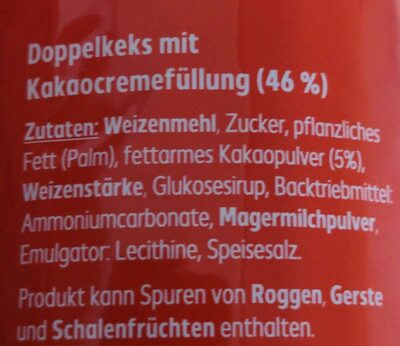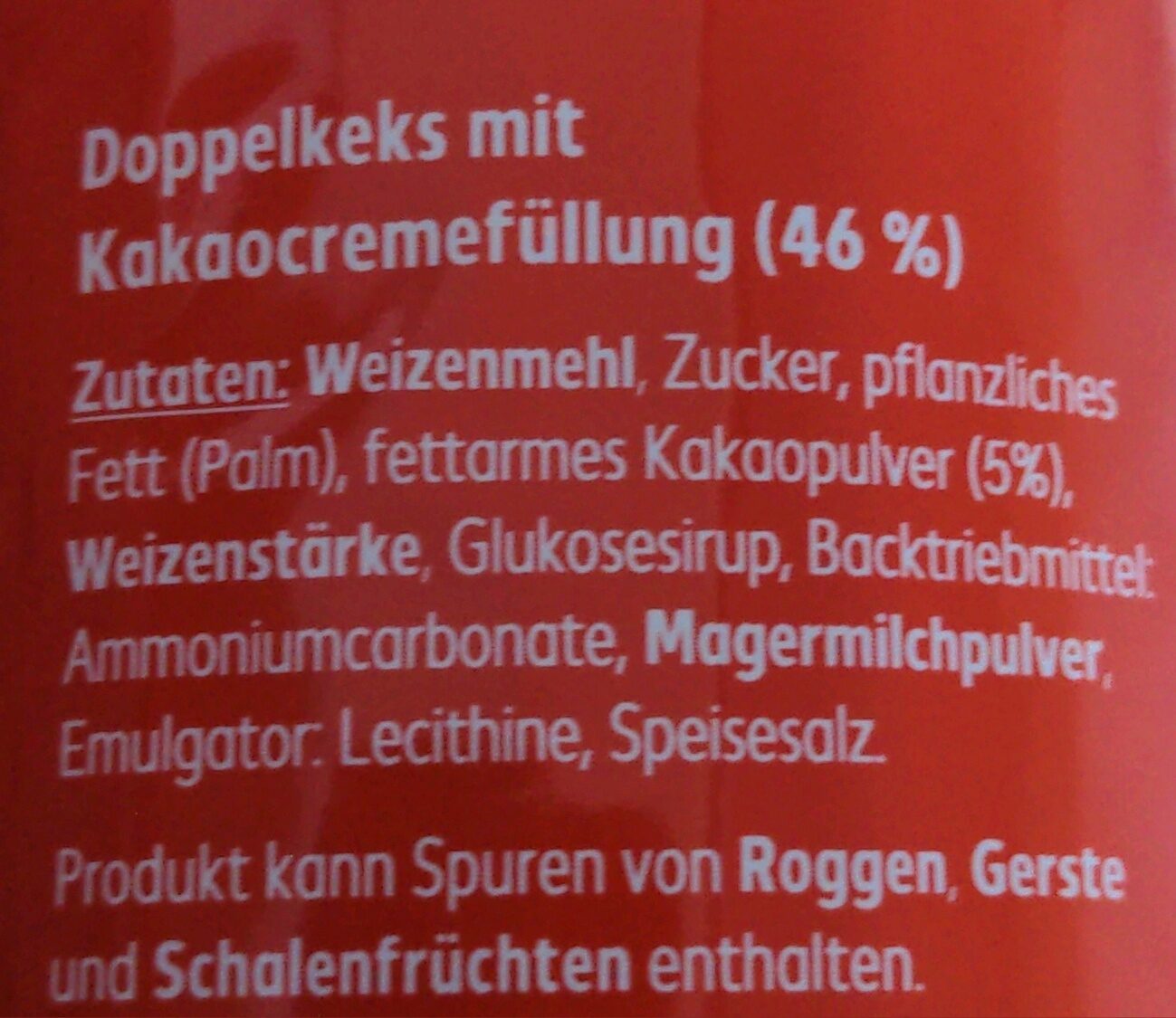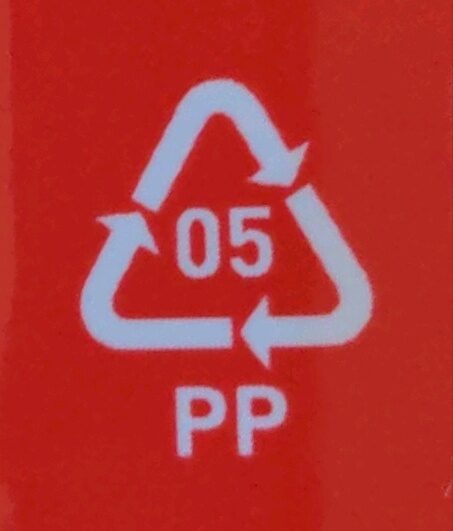Help us make food transparency the norm!
As a non-profit organization, we depend on your donations to continue informing consumers around the world about what they eat.
The food revolution starts with you!
Doppelkeks mit Kakocreme - K-Classic - 500 g
Doppelkeks mit Kakocreme - K-Classic - 500 g
Barcode: 4337185467080 (EAN / EAN-13)
Ainm coitianta: Doppelkekse
Quantity: 500 g
Packaging: en:Plastic, PP 5 - Polaprópailéin
Brandaí: K-Classic
Catagóirí: en:Snacks, en:Sweet snacks, en:Biscuits and cakes, Briosca, de:Doppelkeks mit Kakaocremefüllung, de:Doppelkekse, de:Kekse-mit-kakaocreme
Labels, certifications, awards:
Fair trade, Fairtrade International, Fairtrade cocoa, Nutriscore, Nutriscore D
Origin of ingredients: An Ghearmáin
Manufacturing or processing places: Continental Bakeries Deutschland GmbH, Marie-Curie-Str. 1, 48599 Gronau, Germany
Siopaí: Kaufland
Country: An Ghearmáin, Poblacht na hÉireann
Matching with your preferences
Health
Comhábhair
-
12 ingredients
: Weizenmehl, Zucker, pflanzliches Fett (Palm), fettarmes Kakaopulver (5%), Weizenstärke, Glukosesirup, Backtriebmittel: Ammoniumcarbonate, Magermilchpulver, Emulgator: Lecithine, Speisesalz. Produkt kann Spuren von Roggen, Gerste und Schalenfrüchten enthalten.Hailléirginí: Glútan, BainneTraces: Glútan, Cnónna
Food processing
-
Ultra processed foods
Elements that indicate the product is in the en:4 - Ultra processed food and drink products group:
- Additive: E322
- Comhábhar: Eiblitheoir
- Comhábhar: Glúcós
- Comhábhar: Glucose syrup
Food products are classified into 4 groups according to their degree of processing:
- Unprocessed or minimally processed foods
- Processed culinary ingredients
- Processed foods
- Ultra processed foods
The determination of the group is based on the category of the product and on the ingredients it contains.
Additives
-
E322
Lecithin: Lecithin -UK: , US: , from the Greek lekithos, "egg yolk"- is a generic term to designate any group of yellow-brownish fatty substances occurring in animal and plant tissues, which are amphiphilic – they attract both water and fatty substances -and so are both hydrophilic and lipophilic-, and are used for smoothing food textures, dissolving powders -emulsifying-, homogenizing liquid mixtures, and repelling sticking materials.Lecithins are mixtures of glycerophospholipids including phosphatidylcholine, phosphatidylethanolamine, phosphatidylinositol, phosphatidylserine, and phosphatidic acid.Lecithin was first isolated in 1845 by the French chemist and pharmacist Theodore Gobley. In 1850, he named the phosphatidylcholine lécithine. Gobley originally isolated lecithin from egg yolk—λέκιθος lekithos is "egg yolk" in Ancient Greek—and established the complete chemical formula of phosphatidylcholine in 1874; in between, he had demonstrated the presence of lecithin in a variety of biological matters, including venous blood, in human lungs, bile, human brain tissue, fish eggs, fish roe, and chicken and sheep brain. Lecithin can easily be extracted chemically using solvents such as hexane, ethanol, acetone, petroleum ether, benzene, etc., or extraction can be done mechanically. It is usually available from sources such as soybeans, eggs, milk, marine sources, rapeseed, cottonseed, and sunflower. It has low solubility in water, but is an excellent emulsifier. In aqueous solution, its phospholipids can form either liposomes, bilayer sheets, micelles, or lamellar structures, depending on hydration and temperature. This results in a type of surfactant that usually is classified as amphipathic. Lecithin is sold as a food additive and dietary supplement. In cooking, it is sometimes used as an emulsifier and to prevent sticking, for example in nonstick cooking spray.Source: Wikipedia (An Béarla)
-
E503
Ammonium carbonate: Ammonium carbonate is a salt with the chemical formula -NH4-2CO3. Since it readily degrades to gaseous ammonia and carbon dioxide upon heating, it is used as a leavening agent and also as smelling salt. It is also known as baker's ammonia and was a predecessor to the more modern leavening agents baking soda and baking powder. It is a component of what was formerly known as sal volatile and salt of hartshorn.Source: Wikipedia (An Béarla)
-
E503i
Ammonium carbonate: Ammonium carbonate is a salt with the chemical formula -NH4-2CO3. Since it readily degrades to gaseous ammonia and carbon dioxide upon heating, it is used as a leavening agent and also as smelling salt. It is also known as baker's ammonia and was a predecessor to the more modern leavening agents baking soda and baking powder. It is a component of what was formerly known as sal volatile and salt of hartshorn.Source: Wikipedia (An Béarla)
Ingredients analysis
-
en:Palm oil
Ingredients that contain palm oil: en:Palm fat
-
en:Non-vegan
Non-vegan ingredients: en:Skimmed milk powder
-
en:Maybe vegetarian
Ingredients that may not be vegetarian: E322
-
Details of the analysis of the ingredients
: _Weizenmehl_, Zucker, Palmfett, fettarmes Kakaopulver 5%, _Weizenstärke_, Glukosesirup, Backtriebmittel (Ammoniumcarbonate), _Magermilchpulver_, Emulgator (Lecithine), Speisesalz- _Weizenmehl_ -> en:wheat-flour - vegan: yes - vegetarian: yes - ciqual_proxy_food_code: 9410 - percent_min: 52.91 - percent_max: 85
- Zucker -> en:sugar - vegan: yes - vegetarian: yes - ciqual_proxy_food_code: 31016 - percent_min: 5 - percent_max: 8.5
- Palmfett -> en:palm-fat - vegan: yes - vegetarian: yes - from_palm_oil: yes - ciqual_proxy_food_code: 16129 - percent_min: 5 - percent_max: 8.5
- fettarmes Kakaopulver -> en:fat-reduced-cocoa-powder - vegan: yes - vegetarian: yes - ciqual_food_code: 18100 - percent_min: 5 - percent: 5 - percent_max: 5
- _Weizenstärke_ -> en:wheat-starch - vegan: yes - vegetarian: yes - ciqual_proxy_food_code: 9510 - percent_min: 0 - percent_max: 5
- Glukosesirup -> en:glucose-syrup - vegan: yes - vegetarian: yes - ciqual_proxy_food_code: 31016 - percent_min: 0 - percent_max: 5
- Backtriebmittel -> en:raising-agent - percent_min: 0 - percent_max: 5
- Ammoniumcarbonate -> en:e503i - vegan: yes - vegetarian: yes - percent_min: 0 - percent_max: 5
- _Magermilchpulver_ -> en:skimmed-milk-powder - vegan: no - vegetarian: yes - ciqual_food_code: 19054 - percent_min: 0 - percent_max: 5
- Emulgator -> en:emulsifier - percent_min: 0 - percent_max: 5
- Lecithine -> en:e322 - vegan: maybe - vegetarian: maybe - percent_min: 0 - percent_max: 5
- Speisesalz -> en:salt - vegan: yes - vegetarian: yes - ciqual_food_code: 11058 - percent_min: 0 - percent_max: 0.09
Nutrition
-
Average nutritional quality
⚠ ️Warning: the amount of fruits, vegetables and nuts is not specified on the label, it was estimated from the list of ingredients: 0This product is not considered a beverage for the calculation of the Nutri-Score.
Positive points: 0
- Próitéiní: 0 / 5 (value: 1.4, rounded value: 1.4)
- Fiber: 0 / 5 (value: 0.9, rounded value: 0.9)
- Fruits, vegetables, nuts, and colza/walnut/olive oils: 0 / 5 (value: 0, rounded value: 0)
Negative points: 4
- Energy: 1 / 10 (value: 520, rounded value: 520)
- Siúcraí: 1 / 10 (value: 8.5, rounded value: 8.5)
- Saturated fat: 2 / 10 (value: 2.3, rounded value: 2.3)
- Sodium: 0 / 10 (value: 36, rounded value: 36)
The points for proteins are counted because the negative points are less than 11.
Nutritional score: (4 - 0)
Nutri-Score:
-
Nutrient levels
-
Saill as moderate quantity (4.9%)
What you need to know- A high consumption of fat, especially saturated fats, can raise cholesterol, which increases the risk of heart diseases.
Recommendation: Limit the consumption of fat and saturated fat- Choose products with lower fat and saturated fat content.
-
SáSitheáin saill as moderate quantity (2.3%)
What you need to know- A high consumption of fat, especially saturated fats, can raise cholesterol, which increases the risk of heart diseases.
Recommendation: Limit the consumption of fat and saturated fat- Choose products with lower fat and saturated fat content.
-
Siúcraí as moderate quantity (8.5%)
What you need to know- A high consumption of sugar can cause weight gain and tooth decay. It also augments the risk of type 2 diabetes and cardio-vascular diseases.
Recommendation: Limit the consumption of sugar and sugary drinks- Sugary drinks (such as sodas, fruit beverages, and fruit juices and nectars) should be limited as much as possible (no more than 1 glass a day).
- Choose products with lower sugar content and reduce the consumption of products with added sugars.
-
Salann as cainníocht íseal (0.09%)
What you need to know- A high consumption of salt (or sodium) can cause raised blood pressure, which can increase the risk of heart disease and stroke.
- Many people who have high blood pressure do not know it, as there are often no symptoms.
- Most people consume too much salt (on average 9 to 12 grams per day), around twice the recommended maximum level of intake.
Recommendation: Limit the consumption of salt and salted food- Reduce the quantity of salt used when cooking, and don't salt again at the table.
- Limit the consumption of salty snacks and choose products with lower salt content.
-
-
Nutrition facts
Nutrition facts As sold
for 100 g / 100 mlAs sold
per serving (26,3 g)Compared to: Briosca Fuinneamh 520 kj
(124 kcal)137 kj
(32 kcal)-73% Saill 4.9 g 1.29 g -76% SáSitheáin saill 2.3 g 0.605 g -77% Carbaihiodráit 18.1 g 4.76 g -70% Siúcraí 8.5 g 2.24 g -70% Snáithín 0.9 g 0.237 g -70% Próitéin 1.4 g 0.368 g -77% Salann 0.09 g 0.024 g -83% Alcól 0 % vol 0 % vol Fruits‚ vegetables‚ nuts and rapeseed‚ walnut and olive oils (estimate from ingredients list analysis) 0 % 0 %
Environment
-
Eco-Score B - Low environmental impact
The Eco-Score is an experimental score that summarizes the environmental impacts of food products.→ The Eco-Score was initially developped for France and it is being extended to other European countries. The Eco-Score formula is subject to change as it is regularly improved to make it more precise and better suited to each country.Life cycle analysis
-
Average impact of products of the same category: B (Score: 69/100)
Catagóir: Biscuit (cookie)
Catagóir: Biscuit (cookie)
- PEF environmental score: 0.35 (the lower the score, the lower the impact)
- including impact on climate change: 2.88 kg CO2 eq/kg of product
Stage Impact Agriculture
80.5 %Processing
11.8 %Packaging
3.1 %Transportation
3.2 %Distribution
1.4 %Consumption
0.0 %
Bonuses and maluses
-
Labels with environmental benefits
Bonus: +10
-
Fairtrade International
Fair trade is an arrangement designed to help producers in developing countries achieve sustainable and equitable trade relationships. Members of the fair trade movement add the payment of higher prices to exporters, as well as improved social and environmental standards.
-
-
Origins of ingredients with a medium impact
Bonus: +9
Environmental policy: +4
Transportation: +5
Origin of the product and/or its ingredients % of ingredients Impact An Ghearmáin 100 %Medium
-
Ingredients that threatens species
Malus: -10
Contains palm oil
Tropical forests in Asia, Africa and Latin America are destroyed to create and expand oil palm tree plantations. The deforestation contributes to climate change, and it endangers species such as the orangutan, the pigmy elephant and the Sumatran rhino.
-
Packaging with a medium impact
Malus: -11
Shape Material Recycling Impact Unknown Plastic Ard Unknown Cairtchlár íseal ⚠ ️ The information about the packaging of this product is not sufficiently precise (exact shapes and materials of all components of the packaging).⚠ ️ For a more precise calculation of the Eco-Score, you can modify the product page and add them.
If you are the manufacturer of this product, you can send us the information with our free platform for producers.
Eco-Score for this product
-
Impact for this product: B (Score: 67/100)
Táirge: Doppelkeks mit Kakocreme - K-Classic - 500 g
Life cycle analysis score: 69
Sum of bonuses and maluses: -2
Final score: 67/100
-
Carbon footprint
-
Equal to driving 1.5 km in a petrol car
288 g CO² per 100g of product
The carbon emission figure comes from ADEME's Agribalyse database, for the category: Biscuit (cookie) (Source: ADEME Agribalyse Database)
Stage Impact Agriculture
82.9 %Processing
7.9 %Packaging
3.8 %Transportation
4.7 %Distribution
0.7 %Consumption
0.0 %
Packaging
-
Packaging with a medium impact
-
Packaging parts
(Plastic)
(Cairtchlár)
-
Packaging materials
Material % Packaging weight Packaging weight per 100 g of product Paper or cardboard Plastic Total
-
Transportation
-
Origins of ingredients
Origins of ingredients with a medium impact
Origin of the product and/or its ingredients % of ingredients Impact An Ghearmáin 100 %Medium
Threatened species
-
Contains palm oil
Drives deforestation and threatens species such as the orangutan
Tropical forests in Asia, Africa and Latin America are destroyed to create and expand oil palm tree plantations. The deforestation contributes to climate change, and it endangers species such as the orangutan, the pigmy elephant and the Sumatran rhino.
Labels
-
Fairtrade International
Fair trade is an arrangement designed to help producers in developing countries achieve sustainable and equitable trade relationships. Members of the fair trade movement add the payment of higher prices to exporters, as well as improved social and environmental standards.
Report a problem
-
Incomplete or incorrect information?
Category, labels, ingredients, allergens, nutritional information, photos etc.
If the information does not match the information on the packaging, please complete or correct it. Open Food Facts is a collaborative database, and every contribution is useful for all.
Data sources
Product added on ag prepperapp
Last edit of product page on ag heuwerk.
Product page also edited by alexreactionsmasher, kiliweb, openfoodfacts-contributors, packbot, roboto-app, tacite-mass-editor, yuka.sY2b0xO6T85zoF3NwEKvlhB6eITBm2Paaif5o13Qz_e2DrDTbd0q2KSlMas.













